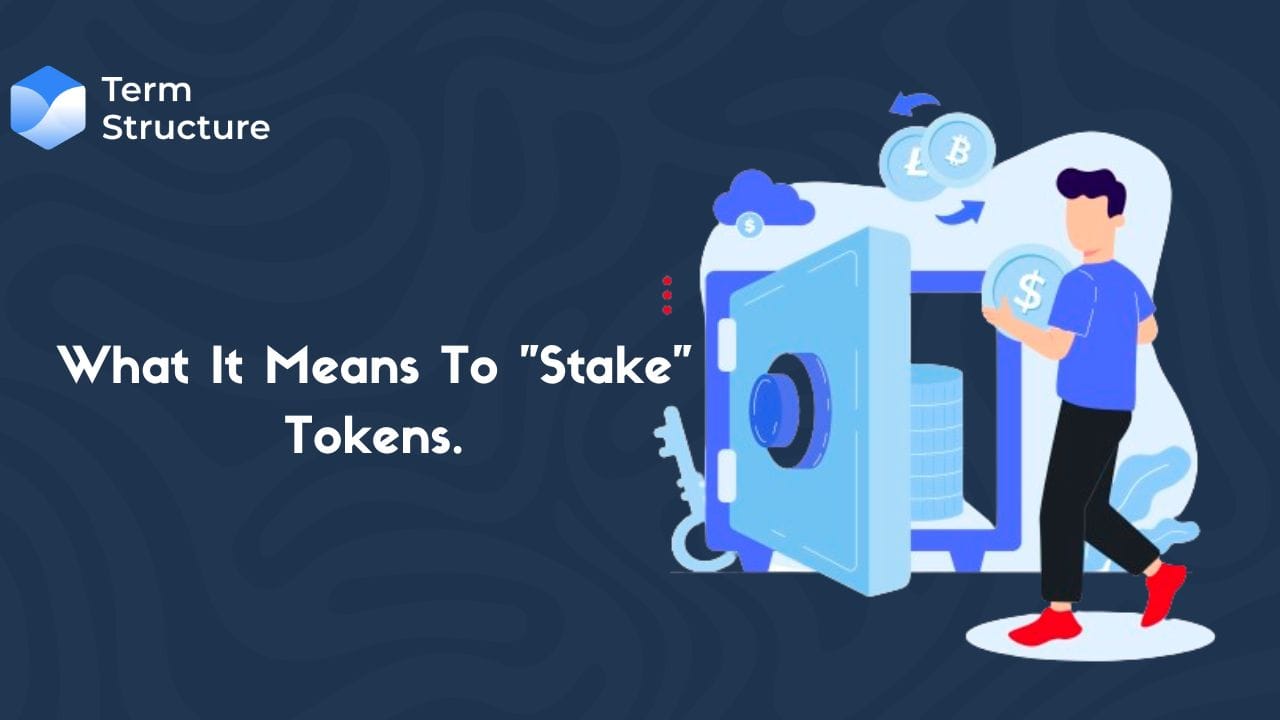What It Means To "Stake" Tokens?

Staking has emerged as a popular method for crypto holders to earn passive income while actively participating in blockchain networks. This article delves into the concept of staking, its mechanisms, benefits, risks, and how individuals can engage in this process.
Understanding Crypto Staking
Staking As A Consensus Algorithm:
Staking here is a feature of certain Blockchains such as Ethereum (Proof-of-Stake) and Solana (Proof-of-History). It involves locking up tokens within a blockchain network to support its operations and validate transactions. In return for staking, participants earn additional cryptocurrency rewards. This process is integral to Proof-of-Stake consensus mechanisms used by these POS blockchains.
Unlike the consensus algorithm of Bitcoin, called Proof-of-Work, where miners solve complex mathematical problems to validate transactions, Proof-of-Stake relies on participants staking their tokens as a guarantee of their commitment to the network's security and integrity.
Staking As An Investment Tool:
Staking here doesn't have or involve any technicality. It is simply a way for exchanges, wallets, and decentralized applications on several Blockchain platforms to increase their value and create utility for their native tokens.
For instance, a decentralized application such as Perpetual Protocol created a staking platform different from its Dapp, which does not affect the technical operations of its Dapp in any way. It only creates utility for the token by reducing the supply and the number of tokens tradable on exchanges while giving returns to the stakers in the form of APY and APR.
Hence two benefits of staking emerge.
Benefits of Staking
Passive Income Generation: Staking allows long-term crypto investors to earn rewards on their holdings without actively trading them. By contributing to the security and efficiency of blockchain projects through staking, participants strengthen the network against potential attacks. This payoff is similar to owning a fixed-income bond that pays you a floating coupon.
Diversification: Staking provides an opportunity for crypto holders to diversify their portfolios and potentially grow their investments through the rewards earned from staking activities. You can stake across different platforms and earn a variety of tokens.
How to Start Staking
Exchanges and Wallets: Staking is generally open to anyone interested in participating, with various platforms offering staking services. Participants can stake their tokens through exchanges like Coinbase, Binance, and Bybit, or wallet platforms like Trust Wallet, Exodus, simplifying the process and eliminating the need for specialized hardware or technical expertise.
This crypto staking guide shows you how to stake different types of tokens.
Decentralized Applications: Certain decentralized applications create their own staking platform for their community to stake tokens (while also partnering with 3rd party staking platforms like exchanges and wallets)
Importantly, when individuals stake their tokens this way they are given another set of tokens that show they have their tokens staked. These staked coins are kept in a vault or put to work within the platform's ecosystem, and participants can unstake them at a later time if they choose to trade or withdraw them.
To know more about the different ways to stake, which coins to stake and their corresponding APRs visit best crypto to stake and stakingrewards.com
Factors to consider before staking your crypto assets
Before staking your crypto assets, there are several crucial factors to consider to make informed decisions and mitigate risks.
Here are five key things to keep in mind:
Price Volatility and Yield: Cryptocurrencies are known for their price volatility, which can impact the returns from staking. Changes in a crypto's price can outpace the yield earned from staking, leading to potential negative returns. Understanding the historical price movements and potential risks associated with price fluctuations is essential before committing to staking.
Liquidity and Lockup Periods: Staking your tokens can reduce liquidity as they are locked up for a specific period. Some cryptocurrencies have lockup periods, various platforms refer to it as un-staking or un-bonding, meaning you agree to keep them staked for a minimum time before being able to unstake and sell them. It's crucial to assess the liquidity implications and lockup requirements of the crypto asset you intend to stake
Network Operation Risks: Consider the operational risks associated with the blockchain network itself. Validator node errors, downtime, or penalties for incorrect validation can impact your staking rewards. Understanding how the network operates and the potential risks involved in the daily operation of the blockchain network is vital before staking
Security and Smart Contract Considerations: Security is paramount when staking crypto assets. Ensure that the smart contract you are staking with is secure, audited, and free from vulnerabilities. Additionally, understanding the mechanics of staking, tokenomics, and the scalability of the platform is crucial to safeguard your assets and maximize rewards.
Regulatory Compliance and Platform Reputation: Before staking, ensure that the platform or exchange you choose is reputable, secure, and compliant with relevant regulations. Understanding the legal environment and regulatory requirements for staking activities can help protect your investments and ensure a smooth staking experience.
However, instead of bothering yourself with regulation and compliance, you can opt for staking in decentralized platforms as they give the highest APY.
Conclusion
In conclusion, staking presents an opportunity for investors to earn rewards while actively contributing to a blockchain network's security and functionality. By understanding the fundamentals of staking, its benefits, risks, and how to engage in this process, individuals can make informed decisions regarding their participation in crypto staking activities.

